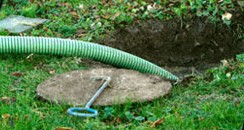More than 20 million households in the United States rely on private septic systems, not public sewer systems, to handle their household wastewater. The determining factor is the home’s proximity to a public sewer system, and in rural areas, it just isn’t practical to run miles of pipelines connecting them to municipal systems. Thus, nearly a fifth of the country, depends on these underground liquid waste bins.
Septic tanks are made of either concrete, polyethylene plastic, or fiberglass, and in homes built in 1975 or later, will consist of two connected tanks. They are large, about 4 feet wide by 8 feet long and 6 feet tall, and the top of the tank will typically be less than 1 foot below the ground’s surface. Their holding capacities run from 500 gallons up to 1,750 gallons, and is based on the number of bedrooms, bathrooms, and occupants in the home.
If you own a home with a septic tank, at some point it will need Septic Services in Sanford FL. Septic tank systems collect all the water exiting a home. So along with toilet waste, water discharged from the washing machine, dishwasher, bath tub, showers, and sinks, also enters the septic tank for treatment. The job of the septic system is to receive, collect, treat, and ultimately dispose of the solids and wastewater. Like any other working system in a household, septic tanks should be routinely maintained and inspected.
It is recommended that septic systems be inspected annually. Homeowners should also maintain records of inspections and pumping performed on their septic tank systems. Septic tank inspections are beyond the realm of what a general home inspector can perform, requiring specialized training and knowledge, such as that possessed by those at website.
As part of the Septic Services in Sanford FL, one can expect the inspector to first determine the level of sludge -; solids that accumulate at the bottom of the tank, and that the volume does not exceed a third of the tank’s total. They will check to verify that none of the liquid waste has worked its way to the surface -; an indication that the system is overloaded. An inspection will also confirm that the riser lids are intact, secure, and not damaged. They will also check that the baffles are securely connected to the tank’s outlet and inlet pipes.







